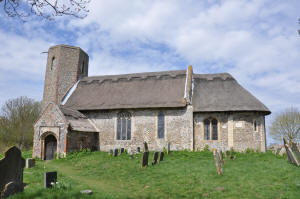|
|
|
|
Heckingham
|
| Heckingham lies 2 miles east of
Loddon. The name derives from the homestead of
Heca's people - hence Heca + ingas (the people of) + ham
(homestead). |

St Gregory's Church Heckingham
|
Today, Heckingham consists of a few farms and houses
scattered over a wide area of land above the River Chet.
However, the Domesday Book records a substantial population
here.
Studies of Heckingham indicate that its settlements
have shifted over time. There is evidence of an early Saxon
settlement to the south of the church and then a movement
northwards during the middle Saxon period towards the valley of the Chet.
Then during the late Saxon period there was a shift back
towards the south - but not as far as the early Saxon
settlement.
Alan Davison has suggested that sea level
rises in the 13th Century may have prompted a movement away
from the River Chet to higher ground.
The population
of Heckingham was small in 1334, had reduced by at least 18%
by 1449 and continued to decline in the late medieval
period.
The church of St
Gregory, which is cared for by the Churches Conservation
Trust, sits on its own on a small hill. It has a round tower
at the base with an octagonal top and a magnificent Norman
south door. It is very similar in design to St Margaret's
Church at Hales - Hales being another deserted (or shifted)
village.
|
|
|
|

